Quote:
Originally Posted by clevermax  Hi friends, romans & Lensmen,
The question is about this lens: Attachment 186167
It is a Minolta Maxxum 70-210 F/4 lens. |
Quote:
Originally Posted by janitha  Never ever try to dissassemble a lens and clean it. Not because you cant do it but since the exact alignment will not be retained once you reassemble
it..... |
Quote:
Originally Posted by clevermax  So I have been going around camera repair shops / watch repair shops and now I have got all the tools & supporting equip. required to open the lens up.
Sadly, the pBase website which had detailed instructions and photographs on dismantling this lens, is down due to a database server crash. I plan to start the 'surgery' once this site is up. I need to save all the documentation and pictures to hard drive before I begin, who knows when this site is going to crash again.
These are the stuff I've got so far, for the lens repair.
1) Screw drivers of the required sizes (picked out of two sets of tool-kits)
2) Tweezers
3) Magnet & small containers to keep the screws & springs
4) Dust free room (Well, almost!)
5) Lint free paper
6) Permanent marker to mark the alignments, positions of mated parts before opening up.
7) Camera ready to take pictures on every step
8) Torch
9) Soldering iron, lead, flex
10) Toothpicks
I plan to buy a pair of white thin surgical gloves so that I don't leave any oily trace by accidentally touching the inner glass.
I am all excited to do this.... |
Quote:
Originally Posted by muni  sounds like a landmark surgery is on the cards. I guess the surgeons themselves would be surprised at your meticulous planning.
I am looking forward for the surgery and pics of course. |
Quote:
Originally Posted by aburagohain  I would have loved to act the assistant for the job, cool thing to do. |
Against the odds! Many people discouraged me from doing it myself....
At last, today I planned to open up my beloved Minolta Beercan 70-210 lens for the long pending fungus cleaning.
Here's the table setup. Not looking like a lab for precise operations I know.

I've been documenting each and every step by taking pictures and also by marking mating parts for proper alignment when I put things back. I also had assistance from pBase site where the steps were explained in detail. I took many pictures, but here I am going to explain only the main steps during the dis-assembly with the supporting pictures.
So first off, I removed the front elements. It was easy but immediately after removing, I realized that putting it back with proper focus rotation (Infinity focus stop) will be a difficult thing. I reassembled this part immediately to see if I can do that. It was a success, then I disassembled it again. In between I took pictures with this lens to see if my focus stop is alright. (Do not confuse this with the term f-stop, this is the frontal element's rotation limits I'm talking about)
Frontal element removed:
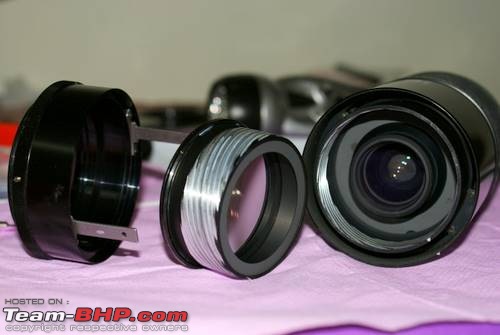
The front element (pair of lenses attached to a cylinder with the helicoid in the outer body for the focusing rotation.
The inner side of the front element had some fungus, but the major deposit was seen deep down inside, and reaching there seemed to be an impossible task, but later I reached there too!
Then I started removing the rear trim rings, but initially the printed circuit board. The screws are very tiny.
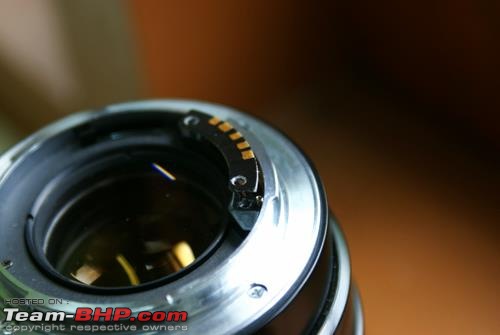
Then removed the back lens mount by unscrewing four tiny screws.
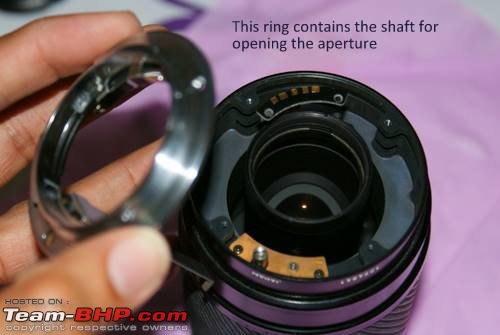

Then came the easy part, removing the rear glass elements, it just un screwed counter clockwise to come out. It was just hand-tight.
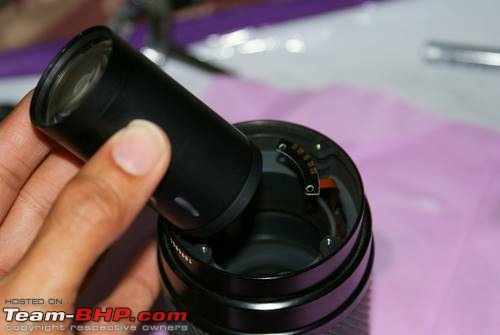
The back element is a small cylinder with two glass pieces at either side.

Whoa!! I found the nesting site of the fungus!

(Picture the huge mother spider in its nesting site as you see in movies) It was on the inner side of this rear element as you can see:

Now the aperture blades were visible and I could see some more fungus on the frontal element's inner side.
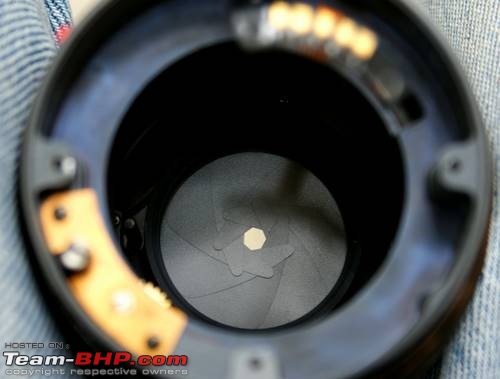
But cleaning that one would require more dismantling, so I proceeded. Now started removing the rear assembly completely.

The picture above shows the zoom encoder - interesting for electronic folks like me.
Another view with the gears for the focusing of front element.

Now removed the rear assembly fully.

The aperture blades are clearly seen now. You can also see the shaft which is actuated for moving the aperture blades.
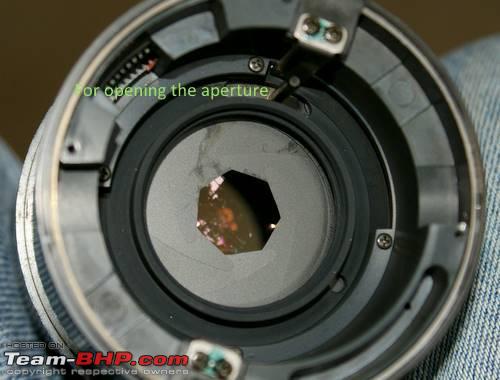
Now I opened up the aperture fully and i could easily reach the inner side of the front element. I cleaned the remaining part of fungus from there too.
Putting it all back together
This was the most difficult part, especially putting the rear lens mount with the aperture shaft, which needs to get alighed properly to the black plastic shaft which you see in the picture above. Putting back some tiny screws was a pain.
Finally, removed the rubber zoom ring, washed it in detergent, applied Armour-All on it, and it looked like new!
This is the lens after re-assembly. You can see some dust on the outer surface, I cleaned it after this picture was taken.
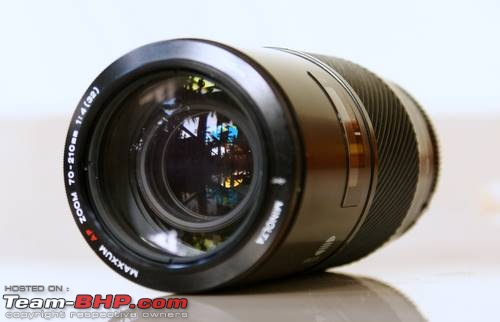

Now, the most thrilling part, I mounted the lens in my camera, and it worked!! It was a relief to hear the sound of autofocus happening for the first time after re-assembly.
Here are a couple of pics taken in very low light, with the cleaned lens. Sorry for the noise, it was taken in higher ISOs.


Autofocus: Perfect
Zoom: Perfect
Infinity focussing: Still to test
Picture sharpness: As before
Lens's structural integrity: As before
Moreover, no screws left out, no squeaking noises heard. I'm very happy with the results.
After reassembly, I took the lens to the car, started the engine, turned on the A/c for few minutes to de-humidify the interiors, and then kept it there inside, since I don't have a dry-box. I did this because there can be moisture trapped inside due to the dis-assembly. This will become dry quickly in dry air.
 (1)
Thanks
(1)
Thanks












 (Picture the huge mother spider in its nesting site as you see in movies) It was on the inner side of this rear element as you can see:
(Picture the huge mother spider in its nesting site as you see in movies) It was on the inner side of this rear element as you can see:










 He said it is unimaginable to him.
He said it is unimaginable to him.
